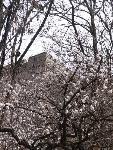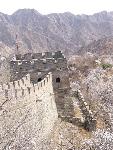- Getting around Lijiang. Dont stay in the Old Towns more than 2 days, there is nothing to do. KRISS Oct 9, 2013 05:46
- 2013 Beijing Temple Fair BENNYLAU Feb 26, 2013 03:29
- Malaysian traveling from KUL - LAX vis Shanghai PVG ZATI_DY Jan 3, 2013 20:15
Taking to the Wall - Mutianyu
- Views: 3040
- |Vote: 0 0
- |Add to Favorites
- |Recommend to Friends
Choose Your Wall
Whether you’re just visiting China for a few days or staying a lot longer, one of the things you’re sure to want to do is visit the Great Wall. It’s one of China’s most prominent icons, representing both the ingenuity of the Chinese civilisation and the antiquity of the country’s heritage. It’s one of the locations travellers simply must visit if they want to experience China’s unique place in the world.
Of course, the very fact that makes the Great Wall so famous – the very length of the thing, spanning the greater part of the country – means that there are multiple locations at which the Wall may be visited. There are some restrictions, however – although until recently it was acceptable for foreigners to walk along the entire length of the wall from the ocean tip at Shanhaiguan right to the western end at Jiayuguan (William Lindesay was the first to do so in 1987, although he did it the other way around). Now, in the interests of protecting the Wall from further deterioration due to tourist activity, walking the ‘Wild Wall’ is now restricted and foreigners are encouraged to arrange visits to officially opened sections.
That’s hardly a problem – the bodies responsible for the Great Wall have made every effort to ensure that the areas of the Wall open to the public are suitably restored and in good condition, as well as convenient for all classes of travellers. Given that some of the most completely renovated sections of the Wall are within one or two hours’ drive from Beijing, the capital’s the ideal starting point for the average traveller’s pilgrimage to the Great Wall.
Most visitors choose between three principal and highly recommended sites. The most popular, Badaling, is a relatively easy section with well-developed tourist facilities, including a chairlift to the top for those who’d love to get there but couldn’t possibly climb all those stairs. It’s also the most frequently visited, meaning that on almost any day of the year you’ll be sharing the experience with thousands of others, for better or worse. A second, Simatai, is a little more remote. It’s in more of an original condition, and more popular with purists and healthy backpackers who leap at the opportunity to bound up steep broken stairways and peep out from desolate crumbling watchtowers.
Mutianyu is considered the middle ground. Although it’s still relatively well-visited, it’s a lot less crowded than Badaling, and more easygoing than Simatai. Mutianyu is 90 minutes from the capital by coach or private vehicle, and is a charming section of the Wall that still provides the same views as hundreds of years ago when the Qing dynasty poet Sun Xueshi wrote of the valley area visible from the battlements – enthusiastically writing of “a thousand trees of peach blossom and ten thousand willows”. Bill Clinton himself visited Mutianyu in 1998 and said that “The Great Wall here is very beautiful, very grand, more beautiful and grander than what I imagined”. He did a lot better than Richard Nixon did on his historic visit to the Great Wall in 1972 – he commented, rather foolishly, “it sure is a great wall”.
The Approach
I was very lucky to be invited to visit Mutianyu with a group of language students from Beijing’s prestigious Foreign Languages & Culture University. Language students in Beijing these days are encouraged to gain a deeper understanding of China than the somewhat dryer knowledge provided by a language textbook, and universities like this one regularly organise trips to important cultural sites so that students may grow to more deeply appreciate China. I travelled in a coach with students from all across the globe, all chatting amiably in varying levels of Mandarin.
We were immediately welcomed to the wall by the familiar cries of traders – and at Mutianyu, there’s no shortage of them. The drive leading to the main entrance holds a veritable community of stalls that have on offer, alongside T-shirts and hats and the usual assortment of trinkets, some very smart and amazingly inexpensive Chinese ornaments and traditional garments. Beautiful silk nightgowns adorned with swirling dragons, high-collared dresses and jade statues of Buddhas, lions and the Great Helmsman, China’s beloved Chairman Mao, are all on display at unusually reasonable rates – although bartering is often required to achieve up to 90% off the asking price. Nearby along the same stretch, many small homes and agencies advertise the chance to stay in the area with a local Chinese farming family – an opportunity that promises relatively inexpensive and generous Chinese hospitality. Those who wish to take a more leisurely and comprehensive tour of Mutianyu can elect to stay overnight with these local families and enjoy home cooking as part of the package.
Mutianyu’s entrance ticket is RMB 35, although for an extra RMB 5 you can purchase a special souvenir ticket that includes an explanatory video CD. Student tickets are half price – I was very lucky to be head-counted with the students, which allowed me the chance to enjoy the site at reduced cost!
There are a couple of other options too. Just as at Badaling, a 500 metre cable car is operated from ground level to carry less able-bodied folk – and American presidents – to the Wall at the crest of the mountains in just five minutes. Most of the students I was travelling with balked at the idea of lazily cruising to the top – for the youngsters, the challenging climb is a necessary part of the experience. However, many of them were quite interested in the thrill of a ride down on a toboggan sled, manufactured by a German company and providing high-velocity descents from the wall that Ming dynasty guards could never have dreamt possible. Return cable car tickets are RMB 50/25 and single journey tickets are RMB 35/18, and the toboggan ride is RMB 40/27.5 or RMB 55 if you take the toboggan’s chairlift on the way up.
I was determined to use my legs both ways, and headed up one of the two staircases set into the mountain slope – neither of which is a particularly easy climb. Puffing and calf-muscle rubbing breaks afforded excellent opportunities to survey the increasingly impressive scenery.
Along the Dragon’s Back
Those more familiar with the story of the Great Wall will know that those parts we see most often today date back from the Ming dynasty – making them about 700 years old – and that the Wall then was based on sequences of earlier walls that had been extended and joined together over a process of more than a millennium’s work. Mutianyu saw its first wall built way back in the Northern Qi dynasty that lasted from 550-577AD, but its Ming period facelift resulted in the more fortified, imposing look that visitors will see today. This part of the wall extends for around three kilometres and is reported to have some unique architectural features. As different parts of the wall were constructed at different times and supervised by different officers, each segment has recognisable and often unique aspects that distinguish it from others.
According to the documentation, that which is unique to Mutianyu is the battlement design – featuring crenels on both sides of the wall, and not merely the side opposing the enemy. This means that Mutianyu was a highly defensible part of the Great Wall – although by the time I’d reached the top and had begun to walk along it, I really wondered how safe it needed to be – climbing the mountain even by staircase was tough enough, and it seemed unthinkable that an invading army would have even been able to cross the peak alone even if the wall had never been built. Staring out into the mountain valley, I saw range after range of uninviting peaks – and yet, even though it seemed a foolhardy task, hundreds of years ago whole armies clambered up and over every one of those slopes, intent on conquering the Empire.
The staircase leads to the eighth and tenth towers in a row of 20 that are open to the public - some of these being much more complicated in design than others. Most people walk the most forgivable section between there and the 14th tower at the top of the cable car. Just the sight of the Great Wall swooping upward, higher and higher as you turn every bend, is enough to make you wonder how long your stamina will last...
For the brave and the strong, heading for the twentieth tower will involve a demanding climb – but reward exceptional views of the surrounding Huairou County countryside. Heading back towards the east will treat visitors to the sight of some unusual watchtowers. Tower number 4 features a courtyard enclosed by three interconnected watchtowers, where the Wall gets so steep that it’s said that an eagle flying to the top will have to ascend at 90 degrees to the ground.
Mutianyu is a simple and thoroughly memorable section of the Great Wall. Climbing with students, I was delighted to be in the company of enthusiastic and respectful visitors who understood that a visit to the Great Wall is a chance to glimpse something of the pride of China, and to be allowed a vision of what can be made possible by Chinese hands.






 Copyright © 1998-2025 All rights reserved.
Copyright © 1998-2025 All rights reserved.
1.
May 3, 2006 21:12 Reply
ANNECY said:
Try the section Jinshanling next time! it is more beautiful and interesting.Your can hike from Jingshanling to Simatai,the length is 15 kilometer and you can walk during 4 hours. It is wonderful!